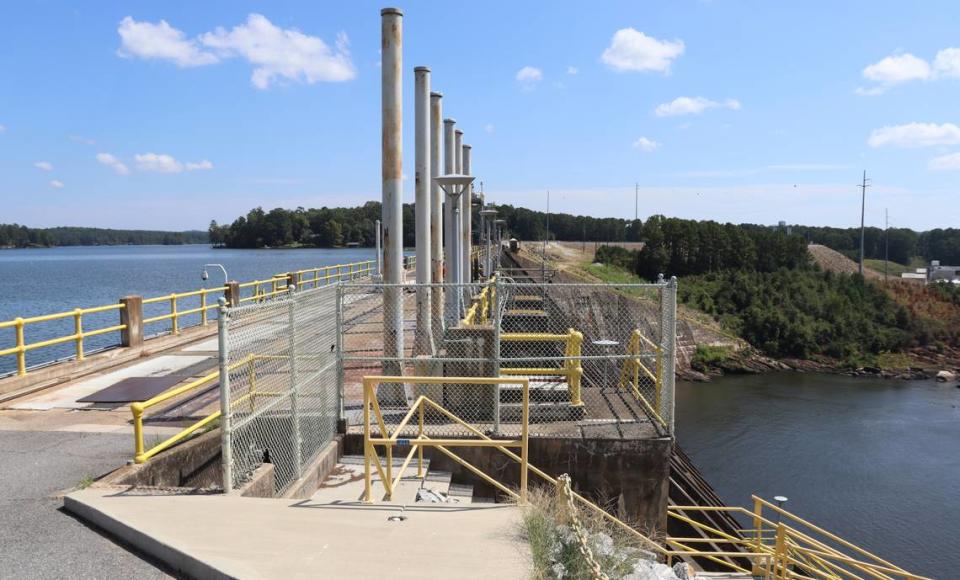Can Bartlett’s Ferry Dam cut Georgia’s reliance on coal? Feds will spend $2.9M to find out
At around 2 p.m. every day, especially in the summer, energy demand in Georgia spikes as A/C units battle afternoon heat.
Demand increases again around 5 p.m. when people arrive home from work, turn on lights, cook, use the dishwasher, and turn on a favorite show to stream on TV.
These daily spikes in usage are known as peak energy.
In Georgia, peak energy is supported by myriad sources including solar, wind, natural gas, biomass, nuclear, hydropower and coal.
Wednesday, the U.S. Department of Energy announced it will support the research and development seven hydropower projects with $13 million in grants from the Bipartisan Infrastructure Bill, including one on the Chattahoochee River just north of Columbus.
“Renewables like wind and solar are intermittent,” Corey Vezina, hydropower program manager at the energy department, said. “One of the great things about hydropower is flexibility. Because it is kinetic power, at a moment’s notice, hydro storage can turn on and stabilize the grid.”
The funding will be used to test the applicability and feasibility of retrofitting existing dams to be more efficient and reliable to meet peak demands, removing the need to rely on carbon-intensive energy from coal power.
“Pump storage can help prevent power loss and blackouts,” Vezina said.
Bartlett’s Ferry
The 173-megawatt (MW) Bartlett’s Ferry Hydroelectric Damn was built almost 100 years ago in 1926. It sits at the border of Alabama and Georgia on the Chattahoochee River, 30 minutes north of Columbus. The facility has never received a major upgrade, until now.
Georgia Power will use a $2.9 million DOE grant to test the feasibility of Pumped Storage Hydropower (PSH) — one of the most popular and well-known efficiency upgrades to dams.
“[Georgia Power] pushes a button to reverse the dam turbines,” Chris Manganiello, Chattahoochee Riverkeeper, said. “You let the water flow downhill into the reservoir, when electrical demand recedes you can pump the water back up from the lower to the upper by reversing the dam turbines and sucking water back.”
PSH began coming online in dams throughout the 1960s and into the early 1990s. Today, there are only 43 dams that use PSH and four are in Georgia: Rocky Mountain northwest of Rome, Richard B. Russell on the border with South Carolina, Carter’s Dam south of Chatsworth and Wallace Dam on the Oconee River, according to the DOE.
PSH will not change the total 173 MW of energy the facility generates, just increase storage capacity during peak flows.
“It doesn’t surprise me that there is an interest in trying to take an old [conventional] dam and make it into a pumped storage facility,” Manganiello said.
Retrofitting the old

Constructing new dams is costly and has far more negative impacts on the environment than retrofitting an old dam. But even that process isn’t simple.
“It’s not easy to build a new [PSH],” Vezina said. “The last storage facility we developed with PSH was in the ‘90s. There are challenges to developing, permitting, funding, and bringing on new PSH facilities.
“We want to develop and test the newest technologies that support pumped storage development, taking existing power and changing it into a way that we can store energy.”
The Bartlett’s Ferry Dam was selected by the energy department because Georgia Power suggested it when they applied for the funding. The funding doesn’t mean there will be construction at Bartlett’s or near Lake Harding.
“The money is going to test what is going to happen when you reverse the spin of the turbines,” Vezina said.
For the next few months, Georgia Power and the DOE will negotiate over funding and then begin testing for the next two-to-three years.


